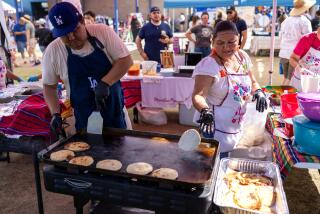Cultures in Conflict : Santa Ana Community of Cham Cambodians Builds on an Island of Faith
- Share via
It is sunset in the village, and the people are gathering in the temple. A crier in an orange sarong stands and, in a resonating tenor voice that the walls cannot hold, calls to the villagers.
“It is time for Muslims to pray,” he sings in Arabic as a few latecomers appear at the door, slip off their shoes and hurry to their places on the floor.
A few minutes later, the crier finishes his azan and Imam Mukhtar Yosof kneels before the group, bows toward Mecca and leads the Cham Temple of Santa Ana in prayer.
Almost 100 Cham Cambodian families live on South Minnie Street in a low-income area on Santa Ana’s east side. It is said to be the largest Cham community in the United States.
To the Cham, the neighborhood of low-rise apartment buildings is “like a village,” said Ahmath El, a Cham Cambodian who fled his native country in 1979.
The Cham are refugees. They are physically similar to the Khmer, the ethnicity of the majority of Cambodians, but are distinct in language, religion and history. Because their Islamic beliefs differ greatly from those of Buddhists, the religion of most Cambodians, the Cham in Cambodia live in their own villages to maintain their piety.
They have congregated on Minnie Street for the same reason. “Cham always live group by group,” El said as he sat with a few visitors in his sister-in-law’s small, simply furnished apartment.
It was El, 38, who founded the Cham community on Minnie Street. A blacksmith in Cambodia under the Communist regime of Pol Pot, he, his wife and three sons fled in 1979 during the confusion caused by the invading Vietnamese.
A few months later, they were sponsored by the International Rescue Committee, a nonprofit refugee relief organization, and they moved from the overcrowded refugee camps in Thailand to Santa Ana.
After only a year in the United States, El asked to sponsor 15 Cham families who were waiting in Thailand. The International Rescue Committee allowed him 10.
“Most people try to sponsor one or two families. This guy tried 10,” said Chanthan Chea, a Khmer Cambodian who often acts as an informal liaison among the county’s Southeast Asian communities. “That made him famous.”
El laughed quietly. “Yeah, everyone knew me. Made me busy all the time,” he said. Before long, the families he sponsored were in turn sponsoring more refugees.
Word spread about Minnie Street’s burgeoning Cham population, attracting Cham families from across the United States, and two Saudi Arabian-educated Islamic priests, Yosof, a Cham Cambodian, and Ahmad Halim, a Cham from Vietnam.
The Cham often refer to Vietnam as Champa, the name of the ancestral homeland conquered by Vietnamese invaders from the north four centuries ago. Most Cham left for Cambodia, a few stayed behind.
Asked if he was from Vietnam, Halim nodded but added, “I am Cham,” so there would be no mistake.
The temple run by Yosof and Halim is the focal point of community life. Prayer is held in the converted apartment five times a day. After school, Halim teaches Arabic and lessons from the Koran to the Cham children, and at noon each Friday, the Islamic holy day, Yosof preaches a sermon.
Different Customs
The Cham adherence to Islamic law often makes life in a non-Muslim society difficult. For example, Muslims eat only meat that has been slaughtered by Muslims according to Islamic law. They do not eat pork at all.
The Cham buy meat from Arab Muslim stores in Garden Grove or Westminster, El said. But this is expensive, so sometimes the men pool their money, go to a ranch in Chino, buy a cow, and slaughter and butcher it themselves.
The children are instructed not to eat the meat in their school lunches, said Dollard Phar, a father of four.
“We try to tell them you cannot eat ham; you can’t eat something like fried chicken,” Phar said. “And they follow our advice.”
However, the Cham have found that some flexibility is essential if they want to function in a society whose values often clash with their own. For instance, they allow their daughters to wear shorts or bathing suits in physical education classes, despite the rule that Muslim females cover as much of their bodies as possible.
‘They Want to Mingle’
“We have big trouble with P.E. that we don’t know how to solve,” El said.
The Cham are torn between following the tenets of their faith and protecting their children from being singled out as different.
“They don’t want people to distinguish them as Cham,” said Chea, program coordinator for the UC Irvine Medical Center’s Southeast Asian Genetics Program. “They want to mingle with other people.”
Another conflict involves Islamic law forbidding women to work where men work. But jobs that pay sufficiently are scarce for recent immigrants. So the women go to work, Halim said, and pray for forgiveness afterwards.
In their homeland, Chea said, most of the Cham were farmers or fishermen. Most have little education--educated Cambodians were systematically killed by the Pol Pot regime--and find it difficult to compete in the job market.
Unlike Vietnamese, Chinese and Korean immigrants, Cambodians are not accustomed to running businesses, and few try it here.
Roughly half of the Cham families are on welfare, El estimated.
El recently started work as a teacher’s assistant at a local elementary school. His wife, Sani Karim, works as an electronics assembler and earns close to the minimum wage. Since both work full time, they do not qualify for welfare.
“Now the big problem is the apartment rent, because the apartment costs more than half our salaries,” El said.
Phar, 35, a military policeman in Cambodia before the Communists took power in 1975, is still looking for work.
The Cham, like most refugees, consider getting a well-paid job their top priority. But their lack of education, difficulty in learning English, culture shock and homesickness combine to discourage them from entering job training programs.
El said some of the older refugees get so homesick upon reaching the United States that they sit at home, stare out the window and leave it to the younger generations to adapt and succeed.
Want to Work
“We worry about the big families who have children,” El said.
El and Phar are eager to dispel a stereotype they have heard: that Cambodians are lazy.
“We are not like that,” El said. “We want to go to work, but we just don’t have the skills.”
But, as a whole, the Cham are adjusting well to life in the states, El, Phar and other Cham said. And they want their appreciation to be known.
“I feel great because we have freedom here,” El said. “We are free to believe in Islam.”
But if freedom ever returns to Cambodia, El said, he would return.
“Yes, we’ll go back.” Pausing, he added, “If it’s the same as before 1970.”
More to Read
Sign up for Essential California
The most important California stories and recommendations in your inbox every morning.
You may occasionally receive promotional content from the Los Angeles Times.










